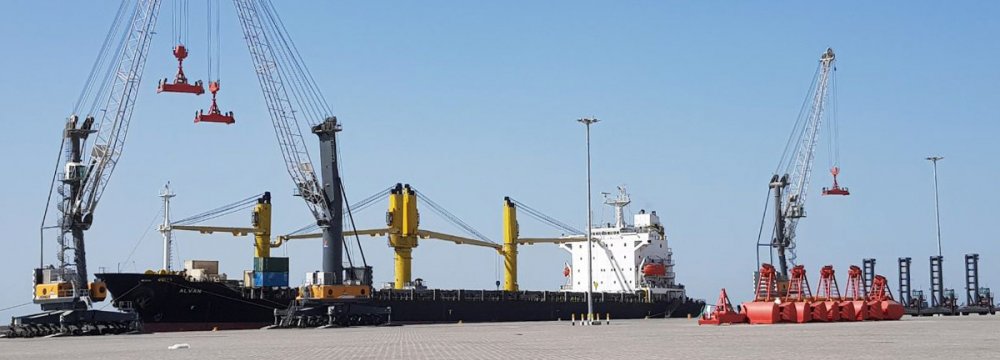Iranian President Hassan Rouhani’s recent state visit to India has strengthened the prospects of India-Iran relations and raised India’s profile in the region.
Indian Prime Minister Narendra Modi had visited Iran in 2016 and the two leaders had met in Ufa, Russia, in 2015 on the sidelines of BRICS/SCO meeting.
Since then, President Rouhani has been positive about developing broad-based ties with India in all spheres and about India playing a larger role in the region, reads an article published by Indian daily The Economic Times. The full text follows:
The development of Chabahar Port is the centerpiece of Indo-Iranian cooperation. The Iranians have already made Chabahar Port functional. Unfortunately, due to bureaucratic apathy on both sides, the construction of a Chabahar port terminal by India has not begun. The Indian credit of $150 million is yet to be released.
India has so far not decided whether to invest in the railroad project to Zahedan. In the interim, the Port and Maritime Organization of Iran and India Ports Global Limited have signed a lease contract for Chabahar Port Phase 1. This was the most visible takeaway from President Rouhani’s visit.
India is learning to engage with the complex geopolitics of West Asia by focusing on geoeconomics.
Rouhani’s visit came after the recent visit of Israeli Premier Benjamin Netanyahu to India and Modi’s successful visit to Palestine, the UAE and Oman.
Rouhani’s visit and his positive reference to India in public statements show that Iran has no issues with the diversification of India’s linkages in West Asia. Iran would like to see India on its side, or at least to be neutral, in its confrontation with the US, Israel and Saudi Arabia. Similarly, India would like Iran to appreciate its concerns on Pakistan supported cross-border terrorism and provide connectivity to Afghanistan, Central Asia, Caucasus and Russia.
Connectivity through Iran is critical for India. Iran is increasingly becoming an important factor in India’s Afghan policy. An example was the passage of 1 million tons of Indian wheat to Afghanistan through Chabahar, bypassing Pakistan. The operationalization of Chabahar will give a fillip to cooperation among Iran, India and Afghanistan.
The 13-member International North-South Trade Corridor is another major connectivity project through Iran. India’s joining the Ashgabat agreement involving Oman, Iran, Turkmenistan, Kazakhstan and Uzbekistan will help India connect with Central Asia. India could begin by starting a shipping line to Chabahar. This will boost traffic through Chabahar to Afghanistan and Central Asia. Eventually, Chabahar could be connected with the INSTC.
It is interesting to note that the joint statements make a mention of Indian investment in Chabahar Free Trade Zone.
But no details have been given. India has an opportunity to increase investment in Iran.
The two countries have agreed to develop their energy relationship beyond the traditional buyer-seller relationship and convert it into a strategic partnership. India must come up with concrete proposals.
India continued to buy a substantial quantity of Iranian oil, thus bailing Iran out in the difficult times of sanctions. The two countries have been discussing for some time the allocation of Iran’s Farzad B Gas Field to India’s ONGC for further development. The negotiations have been protracted and stuck on the price of gas. Hopefully, after Rouhani’s visit, the negotiations will be concluded soon.
The US, Israel and Saudi Arabia are unstated factors in India-Iran relations.
Both countries have shown maturity not to let these factors impinge on bilateral relations.
The prospects of rupee/rial arrangement indicate that both sides intend to protect their economic relations from the uncertainty of Iran-US relations.
On the nuclear issue, India has supported the full implementation of Joint Comprehensive Plan of Action, on which US President Donald Trump has serious objections.
Rouhani’s visit reflects the mutual desire to engage with each other in a range of areas, including defense, security, trade, science, technology and culture. Defense cooperation is an area that needs to be strengthened.
But India has been cautious. Iran appreciates India’s caution. Both sides have expressed the intention to move the relationship beyond trade and investment. But the progress of India-Iran relationship over the last 20 years has been slow and tortuous.
Overall, while Rouhani’s visit does not break fresh ground, it will help consolidate the relationship further. The visit also shows how the two countries are showing maturity and pragmatism in dealing with the ground realities.
India and Iran should show greater ambition in taking the relationship forward. An India-Iran-Oman cooperation in setting up a subsea gas pipeline to take Iranian gas to Oman and India could be considered. This will be a great strategic move.






Add new comment
Read our comment policy before posting your viewpoints